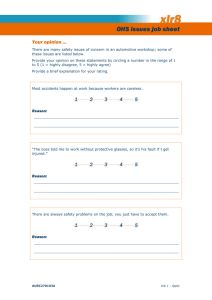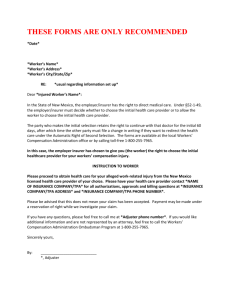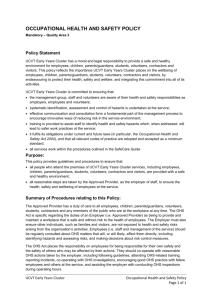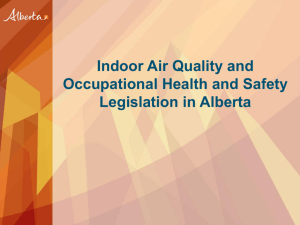Part 4
advertisement
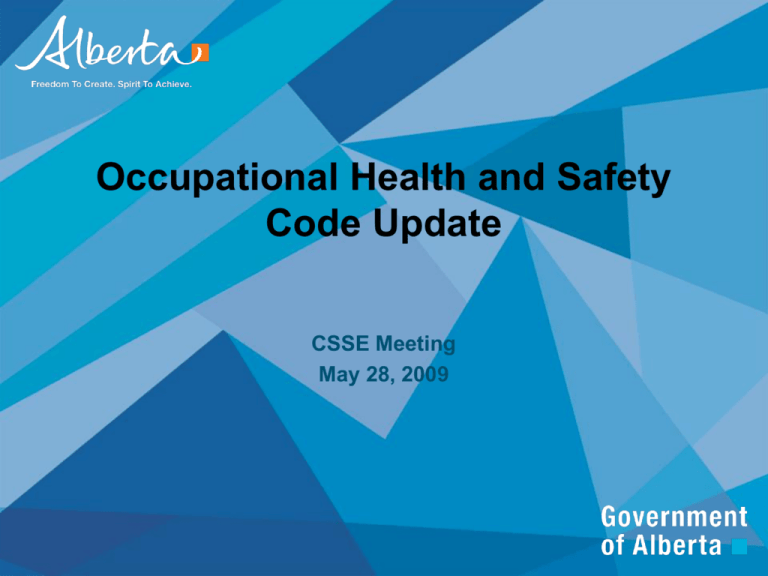
Occupational Health and Safety Code Update CSSE Meeting May 28, 2009 Sections to be Reviewed • • Part 2: Involvement of workers in hazard assessment Part 4: – OELs – Mould • • • • Part 5: New definition of confined space and restricted space Part 6: Load calculations Part 9: New fall protection requirements Part 14: – Health care facilities – Training requirements • • • • • Part 18: Part 19: Part 21: Part 28: Part 35: Requirements for biohazardous materials Concrete pump trucks Fatigue rating Overview Medical sharps Change Process Why the New Edition? • Improve the requirements – create safer workplaces – make requirements current and relevant – eliminate unnecessary requirements • Correct errors A Lengthy Process… • Create OHS Code Review Committee • Create technical committees to deal with specific areas (e.g. OELs, fall protection) • Collect suggestions for change • Prepare a draft for public consultation • Collect suggests from the public • Revise draft • See approval of OHS Council • OHS Council recommends final version to Minister • Minister approves final version via Ministerial Order Overall Changes Highlights of Changes • Occupational Health and Safety (OHS) Code – Comparison of Requirements Between the OHS Code 2006 and OHS Code 2009 • http://employment.alberta.ca/documents/WHS/WHSPUB_li029.pdf Section 2.2 - Designated Person to Prepare Plan • Where the OHS Code requires a plan to be prepared • Must be prepared by a designated person who is competent in the principles and practices of the work described in the plan • Examples: – – – – – – – lead exposure control plan emergency response plan fall protection plan hot tap plan various mine plans health and safety plan (if required by Minister) rope access safe work plan Section 3.1 – Referenced Standards • Listing of previous editions of referenced standards getting out of hand • To minimize this, Section 3.1 was created – allows older equipment to have been approved to, or have met the requirements of an earlier edition of a referenced standard – e.g. 142.2(1) An employer must ensure that a lanyard manufactured on or after July1,2009 is approved to (a) CSA Standard Z259.11‐05, Energy absorbers and lanyards, (b) ANSI/ASSE Standard Z359.1‐2007, Safety requirements for personal fall arrest systems, subsystems and components, or (c) CEN Standard EN 354: 2002, Personal protective equipment against falls from a height — Lanyards. Part 2 Changes to Part 2 • 7(5) A prime contractor must ensure that any employer on a work site is made aware of any existing or potential work site hazards that may affect the employer’s workers • 8(1) An employer must involve affected workers in the hazard assessment and in the control or elimination of the hazards identified Section 7(5) Hazard Assessment • Duty on prime contractor to inform of any work site hazards that may affect an employer’s workers • Ensures that contractor workers coming onto a work site are made aware of existing site hazards that may affect their work but are not necessarily located within their immediate work area. Involvement of Workers in Hazard Assessment • Change meant to emphasize worker involvement, but not beyond current requirements • To demonstrate compliance with this requirement, the employer should be able to indicate which workers were meaningfully involved and to what extent – workers should be able to confirm their involvement in the assessment, elimination, and control activities. – this must be documented Part 4 Changes to Part 4 • Section 16: OELs updated • Section 20: New methods allowed for exposure monitoring • Section 43(6) Allows the Director of Medical Services to require removal of a worker from a work site if the worker is diagnosed with blood-lead poisoning • Section 43.1: Provision for mould Part 4: Updated Occupational Exposure Limits (OELs) • There are almost 800 substances with OELs • OELs currently in the Alberta OHS Code are based on 1999 ACGIH TLVs (with a few exceptions) and were adopted in 2003 • When the OELs were last reviewed, the Technical Working Group recommended that the review be repeated every 5 years. OEL Review Process • Set up an OEL Review Working Group (representation from industry, labour and government) • In principle, 2006 ACGIH TLVs will be adopted • Working group to establish evaluation criteria to identify a short list of substances requiring review Review Criteria • Available scientific documentation and rationale to ensure health and safety to workers • Availability of analytical methods • Limits set in other jurisdictions • Existing and potential compliance issues • Applicability to Alberta • Social expectations Detailed Review • 43 Substances identified for detailed technical review • Rational for identifying these substances: 1. There was a significant difference between the current OEL and the 2006 TLV 2. The substance was suggested for review through the OEL questionnaire (mailed to 77 Associations) 3. The substance did not have an OEL Changes • Coal dust OEL will be reduced, however a one-year implementation period is provided • For the most part, 2006 ACGIH TLVs will be adopted Deviations from TLVs • Acetic anhydride: ceiling recommended instead of 8-hour exposure limit • Formaldehyde, hydrogen sulphide, PAPI, sulphur, ozone,1,1,1-trifluoro-2,2-dichloroethane variations to remain the same • Particulate Not Otherwise Regulated • Suphuric acid will remain the same as the current OEL Deviations from TLVs • Inhalable limits for which the numerical value in the 2006 TLV is the same as the current OEL will remain the same (i.e. the total value will be used) – – – – – – – – calcium sulphate Captan Diquat EPN glass fibres molybdenum nickel silicon carbide, nonfibrous Deviations from TLVs • Inhalable limits for which the ACGIH documentation supports total limits (which may or may not be the same as the inhalable limits) – flour dust (numerically the same) – natural rubber latex (numerically the same) – borates (half the inhalable limit) Non-Consensus Items • • • • • • • Asphalt 2,2-dichloropropionic acid Magnesium oxide Methane p,p-oxybis Trichlorophon Wood dust Expanded List of Analytical Procedures • Expands the range of acceptable methods for measuring/analyzing air contaminants for the purposes of complying with the OEL • In addition to NIOSH, the following are recognize: – – – – – – – U.S. OSHA IRRSST (Quebec) Health and Safety Executive of Great Britain U.S. EPA Sampling Guide of IRRSST of Quebec ISO air quality standards and guides DFG Deutsche Forschungsgemeinschaft New Requirement for Mould • Purpose is to control worker exposure to mould • Where mould can create a work site hazard, it must be controlled in accordance with Section 9 • Best Practice drafted to assist with compliance to this section Part 5 New Definitions • “Confined Space” means a restricted space which may become hazardous to a worker entering it because of (a) an atmosphere that is or may be injurious by reason of oxygen deficiency or enrichment, flammability, explosivity, or toxicity, (b) a condition or changing set of circumstances within the space that presents a potential for injury or illness, or (c) the potential or inherent characteristics of an activity which can produce adverse or harmful consequences within the space • “Restricted space” means an enclosed or partially enclosed space, not designed or intended for continuous human occupancy, that has a restricted, limited or impeded means of entry or exit because of its construction Restricted Space vs Confined Space • Under the current requirements, most trenches would be considered a confined space, but are not subject to the – permitting requirements – atmosphere monitoring – tending worker requirements • Why not? – the hazards have been eliminated or controlled Restricted Space • Think of this as a work location in which the only hazard is the difficulty in getting into and out of the space • Other examples: – below-ground vaults used for telecommunication or electrical cables – interior inspection areas for wind turbine blades – ventilation system passages within buildings – some attics Restricted Space • For entry into a restricted space the following are still required: – a hazard assessment must be completed prior to entry – workers must be trained to recognize the hazards in the confined space and work in a healthy and safe manner – a communication system must be available – entry of unauthorized personnel must be prevented – workers must be protected from hazards created by traffic – workers cannot enter or remain in the space unless an effective rescue can be carried out – a competent worker must be communication with the workers inside – a safe means of entry and exit must be provided Part 6 Changes to Part 6 • 59(2.1) A hoist may only be used for vertical lifting or lowering if it complies with this Part and is designed and manufactured for vertical lifting or lowering. • 68.1 An employer must ensure that a lift calculation is completed for any lift exceeding 75% of a crane’s rated capacity. • Section 70 requirements for tag lines to ensure that they are not used if they can become a hazard to workers Section 68.1: Lift Calculation • Purpose is to ensure that cranes are not overloaded • Establishes a requirement to conduct a lift calculation for lifts expected to exceed 75% of a crane’s capacity • These are sometimes referred to as “critical lifts” • Applies to all cranes but most relevant to mobile and overhead cranes Lift Calculation • A “lift calculation” is a process to ensure that relevant and applicable factors have been considered and calculated – Load information (total weight of item to be lifted, weight of rigging/attachments) – Crane information ( maximum radius, boom length/angle) – Calculated % of crane capacity – Sketch (crane placement, clearance to surrounding facilities like buildings and power lines) Example Part 9 Changes to Part 9 • Training requirements for worker training • Technical standards for equipment • Reduces fall arrest anchor strength requirements to 16 kilonewtons (kN) • Establishes fall protection requirements for fixed ladders and climbable structures • Limited allowance of procedures in place of fall protection equipment Instruction of Workers • Section 141 establishes detailed training requirements for worker training • Specifies a detailed curriculum for fall protection training programs • Includes a practical, hands-on component Instruction of Workers • Curriculum includes – fall protection methods a worker is required to use at a work site – identification of fall hazards – assessment and selection of specific anchors that the worker may use – instructions for the correct use of connecting hardware; – information about the effect of a fall on the human body – emergency response procedures Equipment • Accepts international technical standards for equipment – CEN (European Committee for Standardization) EN standards – ANSI – NFPA • Why the change? – international products offer equal or greater protection – greater variety of products available in Alberta • Products must be “approved” – by nationally accredited third-party organization – products must bear an approval or certification mark – quality assurance Anchor Strength • Fall arrest anchor strength reduced to 16 kN (3600 lbsforce) • Existing 22.2 kN (5000 lbs-force) requirement excessive • Now aligned with European value • Still retains a 2.7 safety factor based on a maximum arresting force of 6 kN Fall Protection on Vehicles with Loads • Recognizes that at times it is not reasonably practicable to provide fall protection when a worker needs to climb onto a vehicle or load • Employer must eliminate or reduce the need for the worker to get onto the vehicle or load • After doing everything possible, the employer can use procedures in place of fall protection equipment Procedures in Place of Fall Protection Equipment • • Concept approved for use by WHS and described in OHS Code Explanation Guide 2006 Procedures can be used in place of “hard” equipment in five cases. They are: 1) 2) 3) 4) the installation or removal of fall protection equipment roof inspection emergency repairs at‐height transfers between equipment and structures if allowed by the manufacturer’s specifications 5) situations in which a worker must work on top of a vehicle or load Part 14 Changes to Part 14 • Establishes site and program requirements for safe lifting of patients/clients/residents in healthcare facilities • Training requirements for specific measures to eliminate or reduce the possibility of musculoskeletal injury Work Site Design – Health Care Facilities • Recognizes that the most significant injury to health care workers is back injury as a result of lifting or transfer of patients • Requires patient lift equipment to be installed in new and renovated health care facilities • Does not apply to health care facility construction, alterations, renovations or repairs started before July 1, 2009 Patient/Client /Resident (PCR) Handling • Employer must develop and implement a safe PCR handling program if workers are required to lift, transfer or reposition PCRs • Program must include an annual evaluation of its effectiveness at preventing worker injuries Training to Prevent Musculoskeletal Injury (MSI) • Workers who may be exposed to the possibility of musculoskeletal injury must be trained in specific measures to eliminate or reduce that possibility (proactive approach) • Training must include – how to identify factors that could lead to an MSI – early signs and symptoms of MSIs and their potential health effects – preventive measures including • the use of altered work procedures • mechanical aids • personal protective equipment Part 18 Changes to Part 18 • Referenced standards updated – – – – – – Protective eyewear Footwear Headwear Firefighters Life jackets Breathing air • Respiratory protection requirements for airborne biological hazards Respiratory Protection for Biological Hazards • 2006 OHS Code requires that RPE be selected in accordance with CSA Standard Z94.4. However, the standard states that the respirator decision criteria do not apply to biohazardous materials • CSA Standard to be revised this year to include biohazardous materials • Until then… Respiratory Protection for Biological Hazards • New requirement in Section 244 to consider biohazardous materials when determining need for RPE • Requires provision of appropriate RPE—decision criteria similar to dealing with a substance with no OEL Respiratory Protection for Biological Hazards • If the effects of biohazardous materials are unknown, RPE must be provided that is appropriate to the known exposure circumstances • Consider: – – – – – – – type of agent route of transmission pathogenicity concentration particle size duration of exposure work procedures • No RPE is required if effective procedures are in place to limit exposure to biohazardous materials Good Reference • Recommendations for the Selection and Use of Respirators and Protective Clothing for Protection Against Biological Agents available at: http://www.cdc.gov/niosh/docs/2009-132/ Part 19 Changes to Part 19 • NEW Requirements for the safe use of concrete pump trucks Failures • In Alberta and British Columbia for the period 2001 – 2004, 20 incidents occurred involving truck-mounted concrete pumping units • 17 incidents involved equipment failures – 14 failures from design or manufacturing deficiencies – two failures due to inadequate inspection and maintenance – one failure was reported to be the result of unsafe operating practices Failures • Failures occurred in – – – – – – – – rotation drive components, an outrigger, a boom linkage, elbows, boom rods, cylinders, welded connection points, a pedestal and a king post tube failure • Most of the equipment failures were on machines that were less than one year old, many only a few months old Requirements • All load bearing components must undergo nondestructive testing at 12-month intervals • Operator must visually inspect all load bearing components and safety and control devices before each use • Outriggers must be extended according to the manufacturer’s instructions • No worker or other person can be positioned under a distribution boom or mast Part 21 Changes to Part 21 • Introduction of the concept of “fatigue rating” Fatigue Rating • “Fatigue” is the tendency of a material to break under repeated stress • “Fatigue Rating” means that the rigging will provide improved fatigue resistance (CEN Standard EN 16771:2000-Part 1) • Section 292(1) permits 20% reduction in breaking strength (when not lifting personnel) if the rigging is “fatigue rated” • Applies to steel rigging only Part 28 Changes to Part 28 • Communication requirement in Section 394(1) revised Communication • Provide effective communication consisting of radio, telephone, (or some other effective electronic system PLUS regular contact at appropriate intervals • Intended to ensure that worker is safe Part 35 Changes to Part 35 • Requires the use of safety-engineered sharps Medical Sharps • Effective July 1, 2010, employers must provide and ensure that any medical sharp is a safety engineered medical sharp • Requirement does not apply if: – use of the required safety-engineered medical sharp is not clinically appropriate, or – the required safety-engineered sharp is not available in commercial markets


